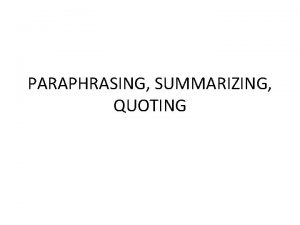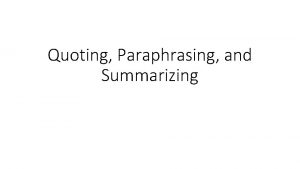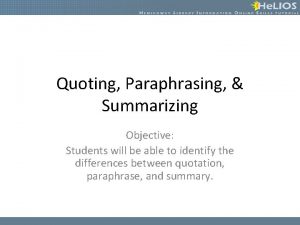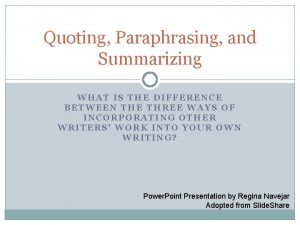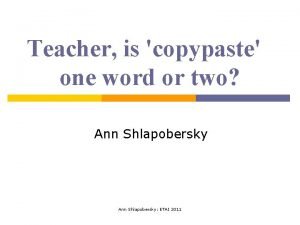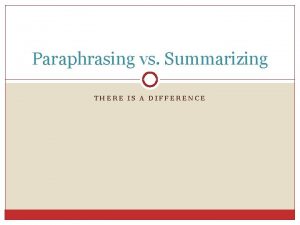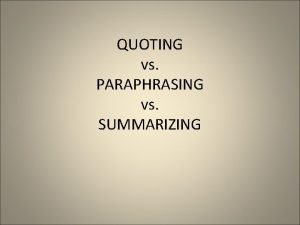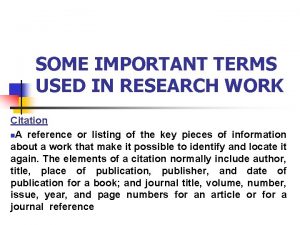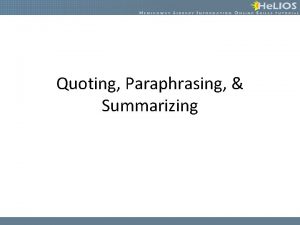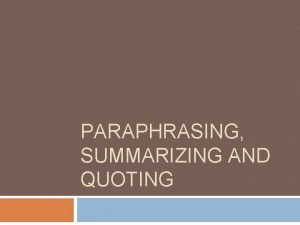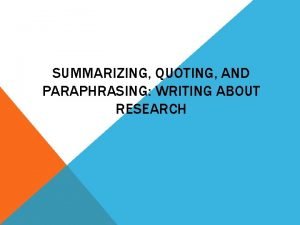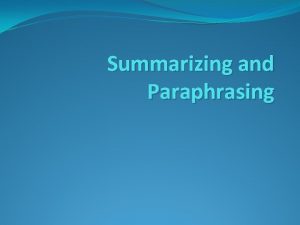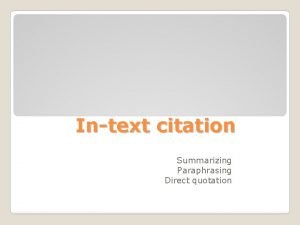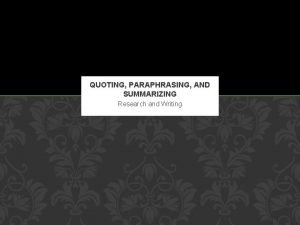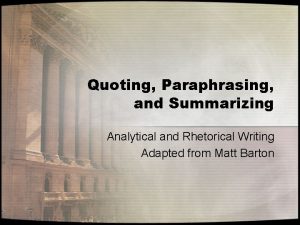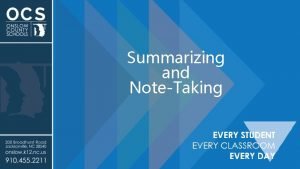Quoting Paraphrasing Quoting Paraphrasing and Summarizing What are











- Slides: 11

Quoting & Paraphrasing

Quoting, Paraphrasing, and Summarizing • “What are the differences among quoting, paraphrasing, and summarizing? – Quotations must be identical to the original, using a narrow segment of the source. They must match the source document word for word and must be attributed to the original author. – Paraphrasing involves putting a passage from source material into your own words. A paraphrase must also be attributed to the original source. Paraphrased material is usually shorter than the original passage, taking a somewhat broader segment of the source and condensing it slightly. – Summarizing involves putting the main idea(s) into your own words, including only the main point(s). Once again, it is necessary to attribute summarized ideas to the original source. Summaries are significantly shorter than the original and take a broad overview of the source material. ”

Using Direct Quotations : In-Text Citations • Author-Page Style of In-Text Citations – “MLA format follows the author-page method of in-text citation. This means that the author's last name and the page number(s) from which the quotation or paraphrase is taken must appear in the text, and a complete reference should appear on your Works Cited page. The author's name may appear either in the sentence itself or in parentheses following the quotation or paraphrase, but the page number(s) should always appear in the parentheses, not in the text of your sentence. For example: • Wordsworth stated that Romantic poetry was marked by a "spontaneous overflow of powerful feelings" (263). Romantic poetry is characterized by the "spontaneous overflow of powerful feelings" (Wordsworth 263). Wordsworth extensively explored the role of emotion in the creative process (263). ”

Using Direct Quotations : In-Text Citations (cont. ) • In-Text Citations with No Known Author – “When a source has no known author, use a shortened title of the work instead of an author name. Place the title in quotation marks if it's a short work (e. g. articles) or italicize it if it's a longer work (e. g. plays, books, television shows, entire websites) and provide a page number. • We see so many global warming hotspots in North America likely because this region has “more readily accessible climatic data and more comprehensive programs to monitor and study environmental change. . . ” (“Impact of Global Warming” 6). ”

Formatting Quotations • Short Quotations (fewer than four typed lines of prose or three lines of verse): “Enclose the quotation within double quotation marks. Provide the author and specific page citation (in the case of verse, provide line numbers) in the text, and include a complete reference on the Works Cited page. Punctuation marks such as periods, commas, and semicolons should appear after the parenthetical citation. Question marks and exclamation points should appear within the quotation marks if they are a part of the quoted passage but after the parenthetical citation if they are a part of your text. For example: – According to some, dreams express "profound aspects of personality" (Foulkes 184), though others disagree. – According to Foulkes's study, dreams may express "profound aspects of personality" (184). – Is it possible that dreams may express "profound aspects of personality" (Foulkes 184)? ”

Formatting Quotations (cont. ) • Long Quotations (more than four lines of verse or prose): “Place quotations in a free-standing block of text and omit quotation marks. Start the quotation on a new line, with the entire quote indented one inch from the left margin; maintain double-spacing. Only indent the first line of the quotation by a half inch if you are citing multiple paragraphs. Your parenthetical citation should come after the closing punctuation mark. When quoting verse, maintain original line breaks.

What is a paraphrase again? • “Your own rendition of essential information and ideas expressed by someone else, presented in a new form. • One legitimate way (when accompanied by accurate documentation) to borrow from a source. • A more detailed restatement than a summary, which focuses concisely on a single main idea. ”

Example of Paraphrasing • “Original Passage: Students frequently overuse direct quotation in taking notes, and as a result they overuse quotations in the final [research] paper. Probably only about 10% of your final manuscript should appear as directly quoted matter. Therefore, you should strive to limit the amount of exact transcribing of source materials while taking notes. Lester, James D. Writing Research Papers. 2 nd ed. (1976): 46 -47. • Legitimate Paraphrase: In research papers students often quote excessively, failing to keep quoted material down to a desirable level. Since the problem usually originates during note taking, it is essential to minimize the material recorded verbatim (Lester 4647). ”

Example of Summarizing • “Original Passage: Students frequently overuse direct quotation in taking notes, and as a result they overuse quotations in the final [research] paper. Probably only about 10% of your final manuscript should appear as directly quoted matter. Therefore, you should strive to limit the amount of exact transcribing of source materials while taking notes. Lester, James D. Writing Research Papers. 2 nd ed. (1976): 46 -47. • Acceptable Summary: Students should take just a few notes in direct quotation from sources to help minimize the amount of quoted material in a research paper (Lester 46 -47). ”

Example of Plagiarizing • “Original Passage: Students frequently overuse direct quotation in taking notes, and as a result they overuse quotations in the final [research] paper. Probably only about 10% of your final manuscript should appear as directly quoted matter. Therefore, you should strive to limit the amount of exact transcribing of source materials while taking notes. Lester, James D. Writing Research Papers. 2 nd ed. (1976): 46 -47. • Plagiarizing: Students often use too many direct quotations when they take notes, resulting in too many of them in the final research paper. In fact, probably only about 10% of the final copy should consist of directly quoted material. So it is important to limit the amount of source material copied while taking notes. ”

Works Cited "Quotation Marks - The OWL at Purdue. " Welcome to the Purdue University Online Writing Lab (OWL). Web. 15 Dec. 2009. <http: //owl. english. purdue. edu/owl/resource/577/01/>. "Quoting, Paraphrasing, and Summarizing - The OWL at Purdue. " Welcome to the Purdue University Online Writing Lab (OWL). Web. 14 Dec. 2009. http: //owl. english. purdue. edu/owl/resource/563/01/. Russell, Tony, and Kate Bouwens. "MLA 2009 Formatting and Style Guide: MLA 2009 Formatting Quotations - The OWL at Purdue. " Welcome to the Purdue University Online Writing Lab (OWL). Web. 15 Dec. 2009. <http: //owl. english. purdue. edu/owl/resource/747/03/.
 Try to practice paraphrasing summarizing and direct quoting
Try to practice paraphrasing summarizing and direct quoting Pepsi coca cola halloween ad
Pepsi coca cola halloween ad Quoting summarizing and paraphrasing
Quoting summarizing and paraphrasing Quoting, paraphrasing and summarizing examples
Quoting, paraphrasing and summarizing examples Compare paraphrasing summarizing and direct quoting
Compare paraphrasing summarizing and direct quoting Insidan region jh
Insidan region jh Difference between summarizing and paraphrasing
Difference between summarizing and paraphrasing Paraphrasing vs. summarizing
Paraphrasing vs. summarizing Paraphrasing vs summarizing
Paraphrasing vs summarizing Direct material sourcing
Direct material sourcing Terms used in research
Terms used in research Quoting dialogue
Quoting dialogue
